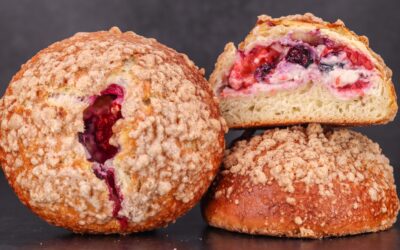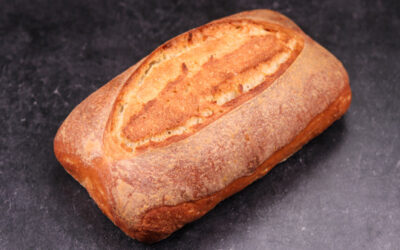Kneading bread dough seems like a waste of time and energy and I’m on a mission to make as many different breads using the no-knead method as possible. I don’t recall kneading a single bread dough this year. And it feels great. Breadmaking has become much simpler. No need to break a sweat and no need to worry too much about temperature calculations.
Lately I have been recreating some of my old recipes using the no-knead and cold fermentation methods, so I thought it’s time for a ciabatta. And what a beautiful ciabatta it is! Fermented in the fridge for 24 hours it has a great depth of flavour. And the 80% dough hydration gives it a wonderfully open and irregular crumb.
When it came to final proofing I went with the classic ‘couche’ method which requires the ciabattas to be placed on a floured piece of cloth and fermented upside-down. This is what gives the ciabatta its classic stripey look.
If you don’t want to mess around with floured towels, then proof them right-side-up on a piece of non-stick paper and bake them that way.
Make sure to steam the oven well to allow the ciabatta to rise and develop a thin and crispy crust.
This recipe makes 6 large ciabattas.
Watch the video down below for detailed instructions.
Ingredients
For the dough –
480g (1.05lb) white bread flour
20g (0.7oz) whole wheat flour
10g (0.35oz) salt
5g (0.17oz) instant dry yeast or 6g (0.21oz) active dry yeast or 15g (0.52oz) fresh yeast
400g (14.1oz) water
The flour I use has a protein content of 13%. If your flour is weaker, then you may need to lower the hydration.
If you are using active dry yeast, then you may need to let it sit in the water for 10 minutes before adding the other ingredients or else it could take a lot longer to raise the dough.
Method
- In a large bowl combine the water, yeast, and salt. Mix well to dissolve the salt completely. Add the flours and mix to a dough. Mix it vigorously for a few seconds to ensure that all the ingredients are well combined. *Desired dough temperature 25C (77F).
- Place the dough in a bowl or better still in a tall-sided baking tray.
- Chill for 15 minutes.
- Fold #1.
- Chill for 15 minutes.
- Fold #2.
- Chill for 15 minutes.
- Fold #3.
- Give the dough another fold after 12 hours has passed. This will give it extra strength and prevent the ciabatta from spreading out sideways.
- Leave in the fridge until a total of 24 hours has passed.
- Tip the dough out on a heavily floured surface. Dust the dough with flour and gently flatten it, and shape it into a rough rectangle. Do not press it too hard or else it will lose its irregular crumb structure.
- Trim the edges and divide the dough into 6 pieces. Dust the exposed parts of dough with more flour.
- Place on the prepared couche with folds in between the rolls so they don’t stick together. Remember to lay them down the right way. The top of the dough was facing the table when you tipped it out. That is the same way it should stay.
- Final proof 1 hour. During this time preheat the oven to 250C (482F) fan off.
- Invert the ciabattas on a peel and slide them in the oven. Steam the chamber, turn the temperature down to 220C (428F) and bake the bread for 20 minutes.
Keep in mind that the conditions in each kitchen are different, so fermentation times may vary for you. It is up to the baker to control the bread and react accordingly.
Your oven may be different too, so your baking time may vary.
Watch the video here



